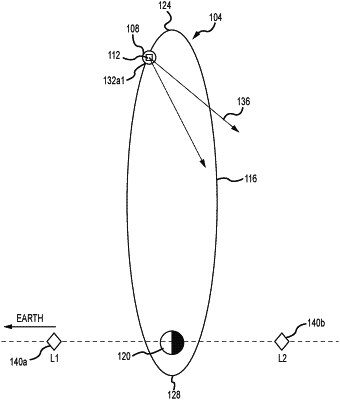| CPC B64G 1/105 (2013.01) [B64G 1/1085 (2013.01); B64G 1/242 (2013.01); B64G 2001/1057 (2013.01)] | 20 Claims |

|
1. An observation system, comprising:
a first spacecraft in a first elliptical orbit about a celestial body, the first spacecraft including:
a first hybrid sensor, the first hybrid sensor having a full frame mode and a scanning mode, wherein the first hybrid sensor is operated in the full frame mode to obtain a first full frame image of a first area of space while the first spacecraft is at or about apoapsis of the first elliptical orbit, and wherein the first hybrid sensor is operated in the scanning mode to obtain a first time domain integration image of a first area of a surface of the celestial body while the first spacecraft is at or about periapsis of the first elliptical orbit, and
a second spacecraft in a second elliptical orbit about the celestial body, the second spacecraft including:
a second hybrid sensor, the second hybrid sensor having a full frame mode and a scanning mode, wherein the second hybrid sensor is operated in the full frame mode to obtain a second full frame image of a second area of space while the second spacecraft is at or about apoapsis of the second elliptical orbit, and wherein the second hybrid sensor is operated in the scanning mode to obtain a second time domain integration image of a second area of the surface of the celestial body while the second spacecraft is at or about periapsis of the second elliptical orbit, wherein a periapsis of the first elliptical orbit is spaced from a periapsis of the second elliptical orbit by about 180°, and wherein about is +/−5°.
|